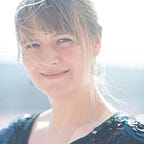Scanning SMK, one sculpture at a time
In June, we had the great pleasure and fortune of a two week visit by Jon Beck and his handscanner! Jon is a volunteer and activist at Scan The World, a community-driven endeavour to scan and share the world’s three-dimensional cultural heritage. SMK Open warmly welcomed his expertise and help to start setting our sculpture collection free in 3D online.
SMK — the national gallery of Denmark is on a quest to open up our vast collection to the public in digital form. Even though we’re the largest art museum in Denmark, we only have space to put less than 1 % of the collection on display in our galleries. This means that the majority of the artworks we hold are in storage most of the time. That’s a big shame, because we’re a publicly funded museum and the artworks belong to all of us. Therefore, they should be accessible to the public. By digitising the artworks, we can go a long way to achieve that.
Our collection spans approximately a quarter of a million artworks, and at least two thirds of those are so old that all rights have expired. That allows us to share the digital reproductions of them with no strings attached whatsoever, by applying the Creative Commons Public Domain dedication to them. So by putting them online in the highest quality we can, we’re able to liberate all those artworks that can’t be on display. In principle. In reality, it requires that the artworks are digitised. And digitisation is a time-consuming and costly affair, which we have to prioritise alongside all the many other things a museum does.
The SMK collection consists of three parts — around 10,000 paintings & sculptures, 245,000 drawings & graphic art, and 3,000 plaster casts. We’ve been digitising artworks for more than a decade but still have a long way to go. Over 100,000 graphic works are still waiting to be digitised, whilemost of the paintings and sculptures have been photographed. That goes both for our unique sculptures, often carved in marble or cast in bronze, and the many study copies of sculptural history from ancient Egypt to the Renaissance we hold, cast in plaster. However, when it comes to sculpture, a 2D picture is not a very fulfilling way to render the artwork. You can only showit from one angle at a time, which is in conflict with the three-dimensionsional nature of the object. New 3D technologies offer to solve this but also require scanning equipment, rendering software, and storage capacity for huge amounts of data — the kind of stuff SMK Open dreams are made of, but which we haven’t been able to fund so far.
That’s why we’re forever grateful that people like Jon Beck exist! Jon and SMK Open share a mutual passion for open cultural heritage. We have a sculpture collection we want to open up digitally. He has the scanner, software, and platform to get it out in the digital open. This past June, Jon made a two week work visit to the SMK to scan away. The first week was dedicated to our plaster cast collection where tirelessly scanned as many casts as was humanly possible, from portrait busts to full figure sculptures. SMK Open team members helped move around the casts so they were accessible to the scanner, and we got to try the fine art of scanning ourselves.
The second week was spent at the SMK in central Copenhagen, where we have a selection of plaster casts on display as well as original sculptures in the museum galleries. Jon would work in the visitor areas and encourage guests as well as museum staff to have a go with the handscanner and hear more about the process of digitising and opening up the three-dimensional cultural heritage at SMK, and in museums all over the world.
An extra twist to the greatness of having the opportunity to share high quality 3D scans of SMK’s plaster casts is that the physical cast collection has been closed to the public since 2016 (except for special occasions) as a way to save costs in a time of continous budget cuts on the Danish cultural sector. While we work towards raising funds to recreate public access to the plaster cast collection, it’s an enormous benefit to be able to offer digital access to experience some of the highlights and rare finds of the collection in top quality 3D scans.
In total, Jon managed to scan 250 sculptures over those two weeks at SMK. While that’s barely 10 % of the cast collection, it’s an incredible achievement for one person! But he didn’t stop there. Later in the summer, he went to Stockholm to scan sculptures at the recently reopened Nationalmuseum, which like SMK has an open access policy for their digitised collection. Right now, Jon is working on rendering all the scans and prepare them to be embedded in the new SMK online collection which will launch early 2020. We can’t wait to share our sculptural heritage with our users in 3D with the Public Domain dedication — and learn what new things people out there will be doing with this new, high quality, open, digital resource.
